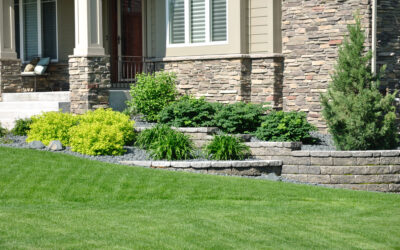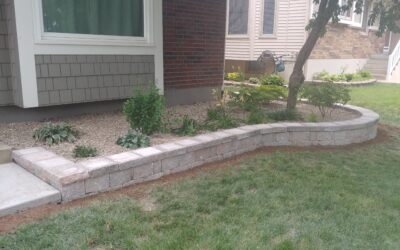Let’s dig right in. Sustainable landscapes are not just a trend, they’re the future of outdoor living spaces. By applying 5 Tips for creating sustainable landscapes, you can craft an environment that flourishes with minimal upkeep and respects our planet’s resources. Ready to transform your backyard into a self-sustaining oasis? You’ll get insights on how native plants can lead to less water use and why soil health is crucial for plant vitality.
From understanding the perks of drip irrigation systems to integrating permeable hardscapes, we’ve got smart solutions that handle stormwater runoff like champs. Plus, eco-friendly materials aren’t only good for Earth—they make your space shine while supporting local economies.
Embracing Native Plantings for Ecological Harmony and Reduced Maintenance
Gone are the days of cookie-cutter lawns. In Lee’s Summit, savvy homeowners now paint their yards with a vibrant palette of native plants. This shift is not just a style statement—it’s a smart move toward sustainability.
Selecting Plants That Thrive in Local Conditions
Picking out plant friends who feel right at home in our local climate means they ask less of us and give more back. These hardy natives have spent eons adapting to Lee’s Summit weather patterns, so they’re tough enough to shrug off pests and diseases that would make others wilt—no pampering needed. The bonus? They cut down on water bills significantly because these green guys sip rather than guzzle H2O.
If you’re keen on creating an outdoor space that pretty much takes care of itself, take a peek at native species recommended for our area. You’ll find flora that naturally syncs up with your backyard ecosystem.
Supporting Local Wildlife with Biodiverse Plant Choices
A single type of plant is like serving the same meal every day—not very exciting for local wildlife looking for variety. By planting native species aplenty, we lay out a buffet table where birds tweet about five-star seeds and beneficial insects buzz happily from flower to flower. It’s this kind of biodiversity bash that keeps ecological balance in check—a party where everyone living outdoors benefits.
To get started attracting those helpful critters while promoting healthy soil teeming with life, consider integrating options from the diverse menu found via this resource on native plants. Not only do these indigenous selections reduce water consumption but they also lower maintenance needs by getting along fine without heavy equipment or constant coddling—talk about low-maintenance luxury.
Key Takeaway:
Go local with your garden. Native plants are the secret to a low-maintenance yard that saves water and supports wildlife. They’re tough, they thrive in Lee’s Summit’s weather, and they create an eco-friendly buffet for birds and bugs.
Water-Wise Irrigation Techniques for Sustainable Landscapes
Thirsty gardens are so last season. It’s time to quench your landscape’s thirst the smart way, with water-wise irrigation techniques that’ll make every drop count.
Implementing Drip Irrigation Systems for Efficiency
Say goodbye to haphazard sprinklers. Drip irrigation systems get up close and personal with plant roots, delivering moisture where it matters most. This direct approach means less evaporation and no more watering sidewalks, maximizing efficiency one drip at a time.
The beauty of these systems lies in their precision—think surgeons of the hydration world. They sneak beneath mulch like undercover agents, keeping the soil moist but never overdoing it because soggy plants are sad plants.
Utilizing Smart Controllers to Adapt Watering Schedules
Smart sprinkler controllers, also known as smart irrigation controllers, revolutionize traditional lawn care by integrating advanced technology to optimize water usage. These controllers utilize a combination of weather data, soil moisture levels, and plant types to create customized watering schedules.
They connect to Wi-Fi networks, allowing users to remotely access and adjust settings via smartphone apps or web interfaces. By leveraging real-time weather forecasts and sensors, they adjust watering frequency and duration, ensuring plants receive just the right amount of moisture. This precision not only conserves water but also promotes healthier lawns and gardens. Overall, smart sprinkler controllers offer convenience, efficiency, and sustainability in managing outdoor water usage.
Gardening should be about growing things—not worries or workloads. So let’s give those old hose habits a rest and embrace an era where sustainable landscapes flourish. Because who doesn’t want more hammock time?
Key Takeaway:
Ditch the old sprinkler and say hello to drip irrigation and smart controllers that make your garden lush while saving water. Get more green, spend less green, and enjoy extra hammock time with these savvy systems.
Soil Health Management for Robust Plant Life
Your garden is only as good as your soil. It’s the bustling metropolis where roots thrive, nutrients are traded, and life blooms. At Evolving Landscapes, we’re big fans of talking dirt—especially when it comes to improving soil health in Lee’s Summit landscapes.
Enriching Soil with Organic Compost
To kick things off right below our feet, enriching soil with organic compost is like throwing a feast for plants. This practice isn’t just about going green; it pumps up the nutrient content without resorting to chemical fertilizers that can do more harm than good over time. Healthy soil practices don’t just stop at boosting plant growth—they revamp the whole ecosystem underground by enhancing water retention and bolstering microbial activity which is essential for plants to absorb nutrients effectively.
Now you might think healthy dirt looks all alike but guess again. The improved structure resulting from healthy soil practices, not unlike upgrading a city infrastructure, allows roots easier access to air and water while giving beneficial organisms VIP lanes to travel through this underground network. What’s even better? These tiny creatures help suppress diseases naturally—talk about having microscopic bodyguards.
If you love numbers like I do—and who doesn’t get excited by stats that support digging into some quality earthwork—consider this: By adding organic matter through compost, you’re directly influencing factors crucial for robust plant life such as improving overall soil structure. Studies have shown that embracing these methods boosts both moisture retention capacity and creates an environment where beneficial microbes flourish—the unsung heroes making sure those tomatoes or tulips grow tall and strong.
The Role of Permeable Pavers in Sustainable Design
Moving beyond what lies beneath towards sustainable design elements above ground level takes us straight into permeable hardscapes territory—a smart move if managing stormwater runoff sounds appealing (and let’s be honest here—it should.). Instead of watching precious rainwater flood sidewalks or disappear into sewers, integrating materials like permeable pavers lets Mother Nature reclaim her hydration cycle back one drop at a time encouraging groundwater recharge along its journey downward.
This innovative infiltration technique not only helps during downpours by preventing erosion but also protects the precious topsoil. It’s like ensuring a strong foundation for skyscrapers, except our buildings are made of flowers, not steel. So if you’re dreaming up ways to cut down on runoff problems, rest assured solid data is backing this melody.
Key Takeaway:
Boost your garden’s growth by enriching the soil with organic compost, which ramps up nutrients and supports an underground ecosystem that fights diseases. Permeable pavers offer a sustainable design choice to manage stormwater and protect topsoil, akin to securing a skyscraper’s foundation—but for flowers.
Integrating Permeable Hardscapes for Effective Water Management
Imagine your backyard as a secret agent in the fight against stormwater runoff. That’s right, by choosing permeable hardscape materials like pavers and porous concrete, you’re not just adding beauty to your outdoor space—you’re actively protecting our precious water resources.
The Role of Permeable Pavers in Sustainable Design
Say goodbye to puddles and hello to natural groundwater recharge with permeable pavers. These savvy surfaces let rain dance right through them back into the earth, keeping your feet dry and your conscience clear. By integrating these surfaces into your hardscape designs at home in Lee’s Summit, you are taking a step towards sustainability that even Mother Nature would applaud.
Evolving Landscapes knows how crucial it is to manage water smartly. They employ erosion control techniques that keep soil where it belongs—supporting plants instead of muddying streams—and reduce the need for heavy equipment repairs caused by water damage on solid paving areas.
Permeable hardscapes, while they may sound technical, are pretty straightforward: they help cut down on pesky runoff issues significantly and aid in replenishing those underground aquifers we all rely on.
Did you know implementing erosion control measures isn’t just good practice—it’s also an investment? You see fewer problems with flooding, which means less cash spent fixing up after heavy rains; it’s economics meeting ecology head-on.
You’ll be pleased to hear that Evolving Landscapes has seen firsthand how incorporating permeable surfaces into their projects can result in a thriving landscape, one that handles whatever weather throws its way without blinking an eye—or creating unsightly drainage problems.
Note: When planning out sustainable landscapes remember: The choices we make today shape our tomorrow. So why not pick options like permeables? They’re easy on the eyes AND environment alike – now that’s what I call a win-win.
Key Takeaway:
Turn your backyard into an eco-hero with permeable hardscapes. These smart surfaces fight stormwater runoff, letting rain seep back into the earth, and saving you money by preventing water damage.
Evolving Landscapes showcases that using porous materials isn’t just eco-friendly; it’s economical too—less flooding equals fewer repairs.
Eco-Friendly Materials & Practices in Landscape Design
At Evolving Landscapes, we’re all about marrying style with sustainability. It’s like peanut butter and jelly; they just belong together. So when it comes to landscaping around Lee’s Summit homes, we pull out all the stops to use eco-friendly materials that leave a light footprint on our planet.
Sourcing Locally for Environmental Impact Reduction
You’ve heard ‘shop local’, right? Well, we landscape locally too. By choosing locally sourced materials for our projects, not only do we cut down on those pesky transportation emissions but also get to high-five our neighbors by supporting their businesses. Plus—and here’s the cherry on top—these sustainable landscapes reduce waste because Mother Nature loves recycled stuff as much as your blue bin does.
Imagine stones gathered from nearby quarries snuggling into your garden bed or locally made pavers expanding your outdoor living space. These aren’t just dreams; this is how Evolving Landscapes rolls—with gardening practices that honor where you live while decking out your outdoor space.
Dig deeper into our commitment and see why choosing locally doesn’t just make ecological sense—it makes economic sense.
Fancy an environmentally friendly yard without compromising on looks? Think native plants and permeable hardscapes—they’re like Batman and Robin fighting against stormwater runoff together. We create designs that are both visually appealing and kinder to natural resources so you can enjoy a beautiful garden guilt-free.
Discover more about permeable pavers here, and learn how these unsung heroes of the hardscape world help keep things drier underfoot during the rainy season—all while doing good for the earth.
With each shovel of soil turned or paving stone laid at Evolving Landscapes, there’s always one goal: design spaces that don’t just look good but do good too. Because who says you can’t have your (eco-friendly) cake and eat it too?
Key Takeaway:
At Evolving Landscapes, we blend style with sustainability for your yard. Think of local materials that cut emissions and support the community.
Choose native plants and permeable hardscapes to fight stormwater runoff. It’s all about crafting spaces that look great and help the planet.
Xeriscaping as a Sustainable Alternative to Traditional Lawns
Imagine turning your lawn into an oasis that thrives without guzzling water. That’s the magic of xeriscaping. This landscaping method swaps out thirsty grass for drought-resistant vegetation, slashing your water consumption and keeping things green even when rain is scarce.
The Aesthetics and Functionality of Xeriscaping Designs
Xeriscaping isn’t just practical; it’s a canvas for beauty. By using plants that are happy with less water, you can craft landscapes that demand attention yet ask for little in return. The key lies in choosing species right at home in Lee’s Summit’s local climate—ones tough enough to stand up to dry spells but lovely enough to make neighbors do a double-take.
But don’t think this means a compromise on lushness or color variety. With careful selection from the palette of native flora available through resources like the National Wildlife Federation’s Native Plant Finder, your yard will become a tapestry woven with vibrant hues and textures—all while reducing water use dramatically compared to traditional lawns needing constant hydration.
Beyond aesthetics, these designs pack some serious eco-punches too. Consider how they ease our precious resource burden: Studies show xeriscaped areas significantly cut down on H2O needs versus their thirstier counterparts—that means big savings on both utility bills and environmental impact.
To get started transforming your outdoor space, take inspiration from Evolving Landscapes’ commitment to crafting sustainable yards by visiting their design page. There you’ll find creative ways to introduce elements such as rock features or mulch beds that not only look sharp but also reduce maintenance demands because let’s face it—who doesn’t love more time enjoying their backyard paradise?
Incorporating xeriscape principles could be one of the smartest moves you make for both wallet and world—it’s truly where form meets function in landscape design.
Key Takeaway:
Transform your yard with xeriscaping to save water and dazzle the eye. Use local, drought-resistant plants for a low-maintenance garden that pops with color and cuts costs.
Conclusion
Embrace the shift. Sustainable landscapes are more than a passing fancy; they’re your ticket to an eco-friendly haven. Remember, native plants are key—they’ll save water and welcome local wildlife right into your yard.
Dive deeper. Water-wise irrigation isn’t just smart; it’s essential for nurturing life without waste. Think drip systems and savvy controllers that adapt to weather shifts.
Nurture below ground too. A healthy soil equals a thriving garden, so mix in some organic goodness like compost to keep those roots happy.
Go with the flow. Integrate permeable hardscapes that let rainwater seep back into Earth—no flooding here!
Pick materials wisely, favoring local over distant sources to cut carbon footprints down to size while boosting community businesses.
The takeaway? These 5 tips for creating sustainable landscapes pave the way for lush outdoor spaces that respect our planet—and look utterly gorgeous doing it.



